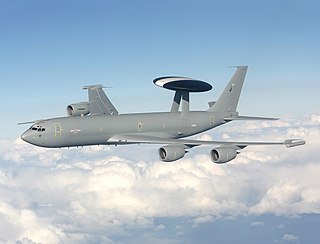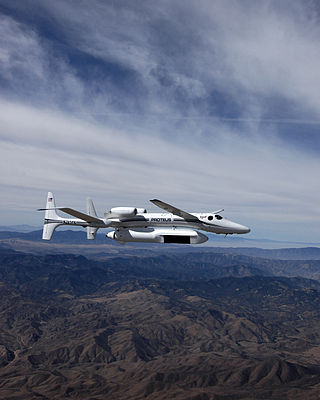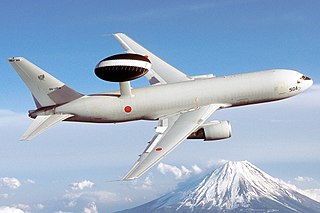
The AGM-88 HARM is a tactical, air-to-surface anti-radiation missile designed to home in on electronic transmissions coming from surface-to-air radar systems. It was originally developed by Texas Instruments as a replacement for the AGM-45 Shrike and AGM-78 Standard ARM system. Production was later taken over by Raytheon Corporation when it purchased the defense production business of Texas Instruments.

The Boeing E-3 Sentry is an American airborne early warning and control (AEW&C) aircraft developed by Boeing. E-3s are commonly known as AWACS. Derived from the Boeing 707 airliner, it provides all-weather surveillance, command, control, and communications, and is used by the United States Air Force, NATO, French Air and Space Force, Royal Saudi Air Force and Chilean Air Force. The E-3 has a distinctive rotating radar dome (rotodome) above the fuselage. Production ended in 1992 after 68 aircraft had been built.

The Northrop Grumman E-8 Joint Surveillance Target Attack Radar System is a United States Air Force airborne ground surveillance, battle management and command and control aircraft. It tracks ground vehicles and some aircraft, collects imagery, and relays tactical pictures to ground and air theater commanders. The aircraft is operated by both active duty U.S. Air Force and Air National Guard units and also carries specially trained U.S. Army personnel as additional flight crew.

The Northrop Grumman RQ-4 Global Hawk is a high-altitude, remotely-piloted surveillance aircraft introduced in 2001. It was initially designed by Ryan Aeronautical, and known as Tier II+ during development. The RQ-4 provides a broad overview and systematic surveillance using high-resolution synthetic aperture radar (SAR) and electro-optical/infrared (EO/IR) sensors with long loiter times over target areas. It can survey as much as 40,000 square miles (100,000 km2) of terrain per day, an area the size of South Korea or Iceland.

A surveillance aircraft is an aircraft used for surveillance. They are operated by military forces and other government agencies in roles such as intelligence gathering, battlefield surveillance, airspace surveillance, reconnaissance, observation, border patrol and fishery protection. This article concentrates on aircraft used in those roles, rather than for traffic monitoring, law enforcement and similar activities.

The Northrop Grumman E-2 Hawkeye is an American all-weather, carrier-capable tactical airborne early warning (AEW) aircraft. This twin-turboprop aircraft was designed and developed during the late 1950s and early 1960s by the Grumman Aircraft Company for the United States Navy as a replacement for the earlier, piston-engined E-1 Tracer, which was rapidly becoming obsolete. The aircraft's performance has been upgraded with the E-2B and E-2C versions, where most of the changes were made to the radar and radio communications due to advances in electronic integrated circuits and other electronics. The fourth major version of the Hawkeye is the E-2D, which first flew in 2007. The E-2 was the first aircraft designed specifically for its role, as opposed to a modification of an existing airframe, such as the Boeing E-3 Sentry. Variants of the Hawkeye have been in continuous production since 1960, giving it the longest production run of any carrier-based aircraft.

An airborne early warning and control (AEW&C) system is an airborne radar system designed to detect aircraft, ships, vehicles, missiles, and other incoming projectiles at long ranges and perform command and control of the battlespace in an air engagement by directing fighter and attack aircraft strikes. AEW&C units are also used to carry out surveillance, including over ground targets and frequently perform battle management command and control (BMC2). When used at altitude, the radar on the aircraft allows the operators to detect and track targets and distinguish between friendly and hostile aircraft much farther away than a similar ground-based radar. Like a ground-based radar, it can be detected by opposing forces, but because of its mobility and extended sensor range, it is much less vulnerable to counter-attacks.

The Raytheon Sentinel is a retired airborne battlefield and ground surveillance aircraft formerly operated by the Royal Air Force (RAF). While based on the Bombardier Global Express ultra long-range business jet, the prime contractor for the Sentinel was the American defence firm Raytheon, which supplied most of the mission systems and performed the integration work.

The Boeing 737 AEW&C is a twin-engine airborne early warning and control aircraft based on the Boeing 737 Next Generation design. It is lighter than the 707-based Boeing E-3 Sentry, and has a fixed, active electronically scanned array radar antenna instead of a rotating one. It was designed for the Royal Australian Air Force (RAAF) under "Project Wedgetail" and designated E-7A Wedgetail.

An active electronically scanned array (AESA) is a type of phased array antenna, which is a computer-controlled array antenna in which the beam of radio waves can be electronically steered to point in different directions without moving the antenna. In the AESA, each antenna element is connected to a small solid-state transmit/receive module (TRM) under the control of a computer, which performs the functions of a transmitter and/or receiver for the antenna. This contrasts with a passive electronically scanned array (PESA), in which all the antenna elements are connected to a single transmitter and/or receiver through phase shifters under the control of the computer. AESA's main use is in radar, and these are known as active phased array radar (APAR).

The Northrop Grumman MQ-4C Triton is an American high-altitude long endurance unmanned aerial vehicle (UAV) developed for and flown by the United States Navy as a surveillance aircraft. Together with its associated ground control station, it is an unmanned aircraft system (UAS). Developed under the Broad Area Maritime Surveillance (BAMS) program, the Triton is intended to provide real-time intelligence, surveillance and reconnaissance missions (ISR) over vast ocean and coastal regions, continuous maritime surveillance, conduct search and rescue missions, and to complement the Boeing P-8 Poseidon maritime patrol aircraft.
Northrop Grumman Electronic Systems (NGES) was a business segment of Northrop Grumman from 1996 to 2015 until a reorganization on January 1, 2016 merged other Northrop Grumman businesses into NGES to form a new segment called Mission Systems. NGES had originally been created by Northrop Grumman's acquisition of Westinghouse Electronic Systems Group in 1996. The Electronic Systems sector was a designer, developer, and manufacturer of a wide variety of advanced defense electronics and systems. The division had 120 locations worldwide, including 72 international offices, and approximately 24,000 employees; accounting for 20% of company sales in 2005.

The Erieye radar system is an Airborne Early Warning and Control System (AEW&C) developed by Saab Electronic Defence Systems of Sweden. It uses active electronically scanned array (AESA) technology. The Erieye is used on a variety of aircraft platforms, such as the Saab 340 and Embraer R-99. It has recently been implemented on the Bombardier Global 6000 aircraft as the GlobalEye.

The Multi-Platform Radar Technology Insertion Program (MP-RTIP), a U.S. Air Force project led by contractor Northrop Grumman to develop the next generation of airborne air-to-air and air-to-ground radar systems. While initially planned for multiple platforms, the MP-RTIP is currently intended only for the RQ-4B Global Hawk UAV.

The Boeing E-767 is an Airborne Warning and Control System (AWACS) aircraft that was designed in response to the Japan Air Self-Defense Force's requirements. It is essentially the Boeing E-3 Sentry's surveillance radar and air control system installed on a Boeing 767-200.
Radar MASINT is a subdiscipline of measurement and signature intelligence (MASINT) and refers to intelligence gathering activities that bring together disparate elements that do not fit within the definitions of signals intelligence (SIGINT), imagery intelligence (IMINT), or human intelligence (HUMINT).
The Space Tracking and Surveillance System (STSS) was a pair of satellites developed by the United States Missile Defense Agency (MDA) to research the space-based detection and tracking of ballistic missiles. Data from STSS satellites could allow interceptors to engage incoming missiles earlier in flight than would be possible with other missile detection systems. The STSS program began in 2001, when the "SBIRS Low" program was transferred to MDA from the United States Air Force. In December 2002, SBIRS Low Research & Development was renamed Space Tracking and Surveillance System (STSS).

Alliance Ground Surveillance (AGS) is a NATO programme to acquire an airborne ground surveillance capability (Multi-Platform Radar Technology Insertion Program on the Northrop Grumman RQ-4 Global Hawk). The NATO Alliance Ground Surveillance Force (NAGSF) was activated in September 2015, after it was formally agreed on the configuration of the unit responsible for operating the remotely piloted aircraft.
The Northrop Grumman AN/ZPY-1 STARLite Small Tactical Radar - Lightweight is a small, lightweight synthetic aperture radar/GMTI radar used in tactical operations. The radar is under contract to the U.S. Army Communications and Electronics Command for its ERMP General Atomics MQ-1C Gray Eagle Unmanned Aerial System and is manufactured by Northrop Grumman. STARLite weighs 65 lb (29 kg)., occupies 1.2 cubic feet (34 L), and requires less than 750W of power. The Army began to take delivery of the system in 2010. Also in 2010 the system was ready for deployment to the battlefield.

The AN/TPS-80 Ground/Air Task Oriented Radar (G/ATOR) is the United States Marine Corps next-generation Air Surveillance/Air Defense and Air Traffic Control (ATC) Radar. The mobile active electronically scanned array radar system is currently being developed by Northrop Grumman and was expected to reach initial operating capability in August 2016.
















